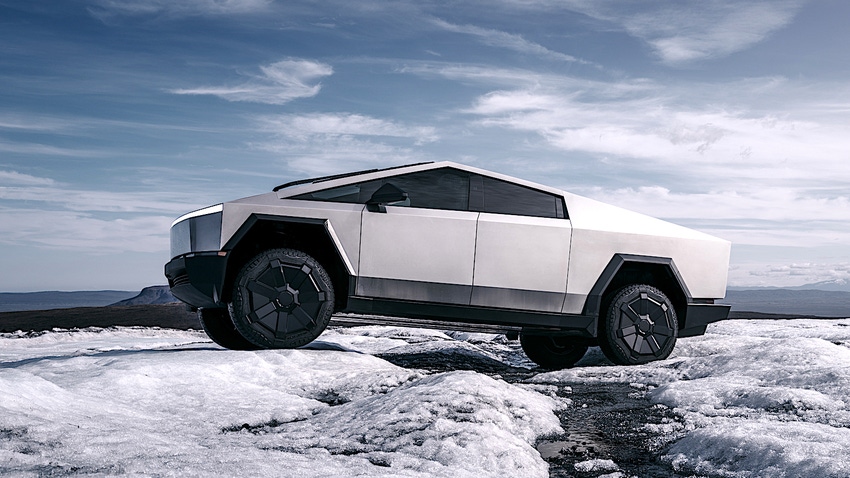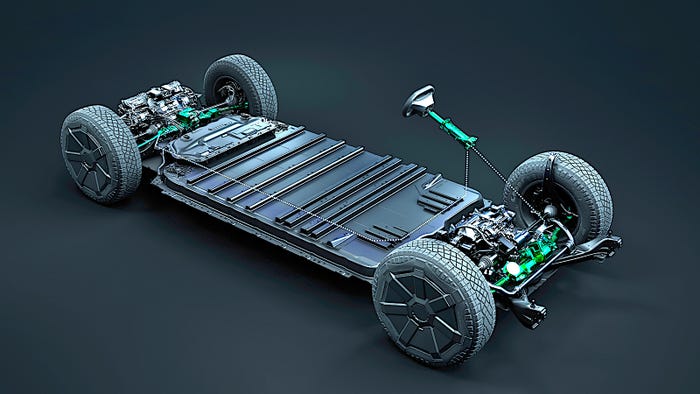Musk Finally Delivers Production Tesla CyberTrucks
What kind of volume qualifies as “production,” remains to be seen, but Tesla has delivered CyberTrucks to buyers.

Four years after Elon Musk announced that Tesla Motors would deliver the angular stainless steel CyberTruck in 2021 for $39,900 to $69,900, the EV mogul has announced the delivery of the first vehicles to customers, with base pricing ranging between $60,990 and $99,990. The least expensive, rear-drive model will be available for purchase starting in 2025.
Consumers looking at pricing on Tesla’s order site will need to be careful because the page deceptively defaults to showing the price consumers will pay after the application of the federal tax rebate, for which the purchase will likely be eligible.
During the delivery event, Musk didn't discuss his previously announced aim of making the CyberTruck float, so that it could be used as a boat. And in a re-staging of the original event’s bulletproof glass demonstration, in which lead designer Franz von Holtzhausen twice broke windows out of the prototype with a thrown steel ball, for this event von Holthausen substituted a baseball for the original steel ball.
It was delivered with a weak throw that was reminiscent of 50 Cent’s embarrassing first pitch at a Mets game. The truck’s glass is now described as “shatter-resistant” rather than bulletproof on Tesla’s website.

Tesla delivered trucks to customers at the event, though the company’s ability to actually manufacture the CyberTruck at scale remains to be seen. Its stainless-steel skin provides some unique production challenges, though Tesla did eventually work through most of the production problems it encountered previously with the Model X’s Falcon Wing doors, so perhaps persistence will pay off in this case too.
Musk touted the stainless-steel bodywork’s ability to repel small arms fire, showing a video where bullets from what was described as a .45 caliber Thompson submachine gun (fired by a gunman who clutched the ammunition magazine rather than the gun’s forward grip while attempting to aim through the gun’s steel sights when firing in fully automatic mode) failed to penetrate the steel.
If a century-old weapon best known for its use by Prohibition-era Chicago gangsters seems curious, consider that while the Tommy Gun was reliable, its shortcomings including high 11-lb. weight, inaccuracy (effective range of only 50 meters), and, wait for it: a lack of penetrating power from its .45-caliber Automatic Colt Pistol ammunition, according to engineer and military historian Bert Kortegaard.

In a separate YouTube video, Tesla employees also fire 9mm handgun ammunition and 12-gauge shotgun buckshot (not slugs) and these also did not penetrate, except for some small holes where multiple buckshot pellets hit the same location.
The bulletproof capability (for a carefully selected list of weapons) is necessary because Tesla delivers “the finest in apocalypse technology,” Musk giggled in the presentation, while seemingly revealing a bit about his outlook. “You never know,” he said, “sometimes you get these late-civilization vibes.” This is underscored by the CyberTruck’s inclusion of the HEPA air filtration system featured on other Tesla models that the company calls the “Bioweapon Defense Mode.”
Behind all the bombast, the CyberTruck delivers some meaningful technical firsts. The truck will be the first production vehicle using a 48-volt low-voltage electrical system in place of the traditional 12-volt system used by all other vehicles. This helps deliver more electricity to power-hungry subsystems over lighter, thinner-gauge wire than today’s 12-volt devices.

Tesla Cybertruck's EV platform. TESLA MOTORS
CyberTruck also debuts the zonal electrical architecture, which reduces the number of processors used from dozens to a handful, as discussed in this Design News article. Musk said that this change reduces the wiring by 70 percent compared to a conventional architecture.
CyberTruck joins the Infiniti QX50 (the one with the impressive variable-compression engine), as the second vehicle to employ steer-by-wire technology. Characteristically for the risk-embracing Musk, Tesla forgoes the redundant mechanical steering backup system that Infiniti uses to let the driver maintain control in case of a failure of the electronic system. Such a backup is not required by the National Highway Traffic Safety Administration, though it does have guidelines for the execution of such systems.
The announced specifications for the CyberTruck cover three variations: a $60,990 single-motor rear-drive entry-level model, a $79,990 two-motor, all-wheel-drive model, and the $99,990, three-motor CyberBeast.
The single-motor truck will have a driving range of 250 miles and it will accelerate to 60 mph in a respectable 6.5 seconds when it arrives in 2025. The dual-motor truck will deliver 600 horsepower that provides 0-60 mph acceleration of 4.1 seconds, a 112 mph top speed, and an 11,000-lb. towing capacity. Driving range is 340 miles per charge.
The CyberBeast’s 845 horsepower rockets the truck to 60 mph in a claimed 2.6 seconds (Tesla puts a big asterisk here, indicating that the test featured a rolling start rather than a standing start and that the time for that rollout is not included). Driving range is 320 miles.
Tesla says that the CyberTruck can recover 136 miles of driving range in 15 minutes of charging on the company’s Supercharger charging network that has established Tesla’s North American Charging Standard as the de facto industry standard for EV charging in the U.S.
For still longer driving range, customers can fill their truck’s bed and further empty their bank account by ordering the optional range extender battery pack, which is claimed to boost the maximum driving range to 470 miles.
The CyberTruck’s adaptive air suspension system provides 12 inches of wheel travel and 17 inches of ground clearance over obstacles. The 6-ft. x 4-ft. cargo bed carries a claimed 2,500 lbs. of payload and because there is no intrusion by arches for the rear wheels, it can hold 4x8 building materials flat on the bed floor with the tailgate lowered.
There are 120-volt and 240-volt power outlets in CyberTruck’s bed that can power tools on job sites, appliances at campsites, or even provide 11.5 kW of power to homes through a bidirectional charger.
How well CyberTruck fulfills these various performance claims remains to be seen when the trucks become available for unbiased third-party testing. It should be fascinating to see how well it delivers on Musk’s hyperbole.
About the Author(s)
You May Also Like





